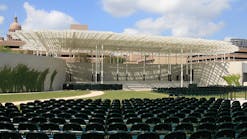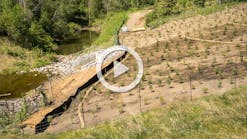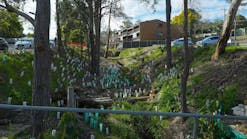Hydroseeding is a growing business. Hydroseeding contractors are tackling projects ranging in size from long stretches of roadside to residential lawns. Customers are recognizing the cost and time benefits of hydroseeding over sod or broadcasting seed. Because of the versatility of hydroseeding, it can be used to establish permanent lawns or landscaping or to provide temporary cover for dirt that will later be moved.
The advantages of hydroseeding include faster germination, increased plant survival, and the ability to cover large, inaccessible areas. The cost is less than that of sod even over flat areas, and it’s a more viable option in areas that are too steep to apply sod. Seed applied in a hydroseed mix will generally show growth and develop turf faster than broadcast seed.
Hydroseeding Basics
The basic materials for hydroseeding are water, seed, fertilizer, and mulch. Water is the carrier for the mixture and also provides moisture to the soil. In hot and dry areas, a contractor might spray water over the ground before the hydroseeding process starts. The extra water lowers the soil temperature and provides a good base for the hydromixture.
The seed varies by the area and the wishes of the client, varying from lawn seed to native seeds with wildflowers added in. In many areas, government contracts call for native seed, and even homeowners are requesting natives.
Fertilizers, especially those with a high phosphorus content, can be added to enhance root growth. Other products, such as soil amendments or chemicals to improve the pH of the soil, can be added to the mix as needed.
Mulch helps protect the seed and seals in moisture. Either paper or wood or a mixture of the two can be used. Tackifiers, to anchor the mixture to slopes and help seal in moisture, are a common addition. A dye is often added for aesthetic purposes and to show the operator what has been covered.
“Quite a bit of our work is with the Texas Department of Transportation [TxDOT],” says Danny Marsh of Southwest Environment Services Inc. in Tyler, TX. “We also work for commercial builders, and we handle all kinds of erosion control work.”
The Texas Transportation Institute tests mulches and approves some for TxDOT use. Highway projects usually specify paper mulch. Southwest Environment manufactures a paper mulch called Enviro-Gro and a 70/30% paper/wood mix called Enviro-Mix. Marsh explains that the biggest problem with paper mulches comes from the source of the paper. If slick papers, such as magazines, are recycled and used in the mulch, it does not absorb water well and tends to cake together like papier mâché, preventing air and water from getting to the seed. The best paper mulch is made from recycled newsprint.
Marsh points out that the soil around Tyler is sandy, often to depths of 3-4 ft. Just miles away, the soil is heavy black clay. Because of these differences, the seed specifications vary by highway district in Texas. For example, in the Paris district (northeast Texas) the mix is Indian grass, bluegrass, and Bermuda. A native wildflower mix is added occasionally. Marsh says that he usually employs a two-step application: first spraying seed and fertilizer and then covering with mulch. “The Bermuda seed is so tiny, it tends to get suspended in the mulch,” he says, so he applies the seed first to increase seed-soil contact. A guar gum—based tackifier, Enviro-Tak, is applied when needed. Marsh says he uses a lot of hay stabilized with tackifier for erosion control situations.
One of the largest recent projects Marsh and his company have taken on was for a new Target Distribution Center. At the time of its construction, it was the largest distribution center in the world, with the slab covering 46 ac. The finished building would have detention ponds and piping to handle rainfall runoff from the roof. The job for Southwest Environment was erosion control before the roof was on with these systems working. Construction crews had moved 1 million yd.3 of dirt and piled it on the back of the property. “Our job was to keep that dirt in place,” says Marsh. His company sprayed native seed along with 5 tons of chicken manure and microbes to enhance growth, then mulched the slopes and applied tackifier. “It’s just part of the landscape now,” he adds.
Mark Myrowich, president of Mid Canada Hydroseeding in Winnipeg, MB, began with residential jobs. But he says now his most common projects are road construction erosion control jobs.
The types of seed he most commonly uses are creeping red fescue, western wheat grass, slender wheat grass, Kentucky bluegrass, annual rye grass, fall rye grass, and oats. He places the seed on the ground and covers it with mulch and Canfor’s EcoFibre tackifier. Most of the time the seed amount is specified by the job. “I put extra seed in when I feel it will make the job perform better,” Myrowich states. If he adds seed, he usually gets more money, but that is not always the most important thing. “It is better to have the job succeed than to be cheap with the seed.” For his projects, Myrowich uses native seed only about 5% of the time.
The addition of fertilizer depends on the soil and the time of the year. “As a rule of thumb, we use 1 pound of actual nitrogen per 1,000 square feet.”
The amount of mulch also can vary by job. Myrowich points out that the biggest factor for machine productivity is how much mulch per acre is needed. “Our usual rate is 2,000 pounds per acre.” The addition of a bonded fiber material also depends on the job specification.
One of Myrowich’s most challenging projects involved working against time in northern Manitoba. “The Highways Department wanted me to hydroseed 125 acres in October. The challenge was that with my machines and the amount of daylight hours, I could not finish the job that fall because it would have lasted well into November, and we are guaranteed to have snow on the ground by that time. I solved the problem by running my Finn T-60 and T-170 24 hours a day.” Working at night and in temperatures as low as -10ºC (14ºF) involved some special adaptations: “We had to place a generator on the deck of the HydroSeeders to power light and to supply electricity to the heat tape that kept the pipes from freezing. The weather cooperated, and we were able to complete the job in 11 days as opposed to 30. A bonus was that by keeping the HydroSeeders working around the clock, the machines did not have a chance to cool down and freeze, which makes it harder to start up in the morning and causes more wear and tear on the machines.”
Little Susitna Hydroseeding in Wasilla, AK, does many erosion control projects for Alaska DOT, as well as some residential and commercial lawn installations. Owner Diana Garner chooses the seed mixture according to the project. “Most DOT projects call for native seed or a percentage of it. Native seeds are hardy and reliable.” She adds, “Most Alaska highway projects specify a 20-20-10 granular-type fertilizer. This is used in native soils with most seed mixes.” She uses EcoFibre wood-fiber mulch for residential applications and Thermo-Kool, a locally produced wood cellulose fiber mulch, for much of the highway work. “I figure proportions by the size of the area to be seeded, the purpose of the vegetation–erosion control, lawn area, wildflowers, hayfield, and so on–and the germination and purity percentages of the seed.”
When necessary, she uses tackifier in the mix, which can have an added benefit after the job is done. “Tackifier makes the mixtures slicker, and therefore the equipment is easier to clean.”
“My company mostly handles highway work for all different types of roads in Virginia,” says Ronnie Guthrie of R.S.G. Landscaping and Lawn Care Inc. in Concord, VA. He adds that the state requires a three-step process for vegetating the roadways. First, a hydromixture of seed, fertilizer, and lime is applied. The seed is usually a turf fescue or, in areas with significant slopes, a hard fescue. In western Virginia, the seed is almost exclusively hard fescue because of its higher drought tolerance. The state highway projects do not call for native seed, but sometimes a wildflower seed mix is added. Guthrie uses a fertilizer rated 15-30-15 to get increased sprouting and root growth. Lime is needed to lower the acidity of the soil.
The second step is blowing straw to increase moisture retention. The final step is applying a mulch and tackifier mix, consisting of 80/20% paper and wood mulch and tackifier. The mulch can be the cheaper mix of paper and wood because it goes over straw.
One of Guthrie’s most difficult projects was a section of highway in Pulaski County, VA. The terrain was extremely rocky and dry, so it was hard to get the straw to stick. Some of the slopes were 1:1, so a bulldozer was required to pull the hydroseeding machine high enough to apply the mixture. The seed used was hard fescue and crown vetch.
Golf courses provide the lion’s share of work for North Shore Hydroseeding Inc. in Danvers, MA. Brian King, president of the company, says many golf course superintendents like to seed the area themselves to get the maximum seed/soil contact. Afterward, North Shore mulches over that. The standard mulch rates that King uses are 1,500 lb./ac. for flat ground and up to 2,500 lb./ac. for severe slopes. Tackifiers are added to sloped sections as well.
King uses humic acid to enhance germination. Late in the season, he pregerminates the seed to give it a push to grow. If it is too late in the season to achieve growth, he sprays dormant seed. Most of King’s jobs include a follow-up fertilizer application.
Many golf course projects call for a native fescue-wildflower mix. Golf courses want to cut down on maintenance costs, such as number of mowings, and use less water. This seed mix also enhances the beauty of the course.
The Front Range of Colorado is one of the fastest growing areas in the country. Housing developments are springing up everywhere, and that’s where J&S Custom Seeding of Security, CO, has its main business. “We do seeding for Norwood Developers,” says Co-Owner Jodi Cubbage. J&S seeds boulevards and open spaces that are too expensive to sod. The company also handles commercial projects, such as landscaping for a new Auto Auction business. The normal load for the 600-gal. tank is 100 lb. of wood mulch and 20 lb. of seed to cover about 8,000 ft.2, according to Co-Owner Steve Cubbage.
Wildflower seed can be added to the load, but it is more expensive. For much of the development work, the seed is called the “foothills mix,” consisting of native grasses, such as wheat grass, grama, rye grass, and hard fescue. For lawn coverage, J&S uses a playground mix of perennial rye, creeping red fescue, and Kentucky bluegrass. Additional seed may be added if the ground is rocky.
Addition of fertilizer depends on the customer desire. Cubbage says he rarely recommends it because it can encourage weed growth. It is usually better to fertilize after the grass has started its growth.
Some parts of the projects must withstand moderate runoff from rain or homeowners’ sprinkler systems. In those places, the Cubbages apply erosion control blankets and seed over them.
Glenn Young, owner of A-1 Hydromulch in Tyler, TX, has homes and commercial erosion jobs as his most common projects. Young also serves as vice president of the Hydro Turf Planters Association. He says, “A root is your best protection for erosion control.”
He prefers to use a wood-fiber mulch and a guar and polyacrylamide tackifier. The amount of mulch needed depends on the coverage and thickness of the mulch as well as the terrain: “On some projects you only get half the coverage you would get on flat ground.”
Young matches the seed to the time of year. In April or May, he might add rye or fescue to a Bermuda grass job to get the quicker root growth for erosion control. German millet added to the mix in the heat of summer will also produce a quicker root. In winter, rye grass doesn’t require as much fertilizer as Bermuda grass does. Native grasses need very little fertilizer. Acidic soil might require lime for some grasses to grow; however, centipede grass thrives on soil with a pH of about 4.5—5.5. Young states, “For erosion control, sometimes we do a mix of several different seed so the ‘best man will win.’”
The most interesting project Young has handled was the lawn of a tiger’s play area where the animal–caged–was on hand to watch the work. Most difficult was an erosion control project at a commercial building. The site had a drop-off of about 100 vertical ft. in 25 horizontal ft. He applied a bonded fiber matrix, critical to slope stability. The seed used was weeping love grass, which grew a sea of grass blowing in the wind.
Sand is the big problem with grass growing in Florida, according to Reggie Tietjen, owner of HydroSeeding Plus in Lady Lake. His company handles many types of hydroseeding projects, from reseeding over fiber-optic cable installation trenches to highway work to mine reclamation. Other professionals use tackifier to attach mulch to rocky soil, but Tietjen is using it to anchor to sand.
A recent project for Tietjen was the reclamation of a sand mine. The soil was white sand that would just suck up water. He received a contract to revegetate the slopes. Even though he has been hydroseeding for five years, Tietjen told the client, “I can stop the erosion. I can’t promise that I can grow grass.” But with the right mix, that’s exactly what he did.
The hydroseeding mixture contained EcoFiber mulch. Tietjen usually applies wood mulch, although on slopes he states that the wood and paper mix will often stick better. The mulch was applied at the rate of 2,500 lb./ac. to form a good, solid mat that would not erode easily. He added StikPlus, a Finn product, which is a tackifier with fiberglass fibers to increase its holding power. He also included HydroGel, a polymer compound that holds up to 500 times its weight in water. It slowly releases the water to be available for the plants, and then when it rains, the gel soaks up another load of water. Tietjen also used Finn HST, a product that contains humic acid, which holds the nutrients in the soil instead of allowing them to leach out quickly.
The seed comprised Pensacola bahai, roundtop millet, and Bermuda. These are native grasses that are required by the Florida DOT. Tietjen states that the seed was germinating in eight days, an amazing result in the sandy soil.
Another challenging project undertaken by Tietjen was for a new housing development. The roads had been built, but no houses had been started. Tietjen was called in for erosion control. He says the sand blew so badly that it was impossible to tell where the roads were. He had to dig his equipment out of the sand every morning before starting work. Applying many of the same products, Tietjen laid down a fairly thick layer, about 1/8—1/4 in., of mulch and tackifier to anchor the sand from the wind.
Hydroseeding land devastated by wildfire was a challenging project for Western States Reclamation Inc. of Broomfield, CO. David Chenoweth, president, says his company received a contract to reseed areas burned around Los Alamos, NM, in the summer of 2000. Much of the work was aerial reseeding because the slopes were too steep to allow hydroseeding trucks to enter. The mixture consisted of mulch, seeds, and urea fertilizer. After a fire, the soil has a higher alkaline content, so the urea is used to lower the pH. In some places, hydrophobic soils must be broken up before the application of hydromulch. Plants were growing well by the end of the season.
Erosion control projects for state and federal governments are the mainstay of business for Precision Hydroseeding Company in Aberdeen, WA. Matthew Maurer, vice president and part-owner, states that the company handles jobs ranging from highway work to reclamation of landfills to some residential yards. The company is a family-owned business that was active in forestry work before moving into hydroseeding.
Maurer says he nearly always uses either wood mulch or a wood/recycled cardboard mixture. He uses products from several companies, including Advanced Fibers, Conwed, and Canfor. The tackifier he applies is a guar gum and polyacrylamide combination. One big advantage of using the polyacrylamide is the decrease of water turbidity in runoff. The polyacrylamide cleans the water enough to meet the strict Washington state standards.
Maurer decides what will work best on site-by-site basis. On residential lawns, he occasionally adds organic fertilizer to develop the soil. Some reclamation projects do require soil amendments, but it varies by site.
State specifications for seed are perennial rye, creeping red fescue, Highland Colonial bent grass, and White Dutch clover. The rye is fast sprouting; the fescue takes longer but develops a deeper root system. The bent grass has an extremely tiny seed, so a large quantity of seeds can be added to the hydroseed mixture. White Dutch clover is used to fixate nitrogen.
On major projects, there is generally not much leeway in the specifications. Maurer points out that sometimes just finding the native species required by some contracts is difficult.
One problem Maurer has faced is working with a product used extensively in other parts of the country: bonded fiber matrix (BFM) materials. Maurer states that the BFM products are great for areas that have to withstand high stress on steep slopes. But he adds, “Our problem here is rain. Those products usually require 24 to 48 hours of dry weather to cure, and we don’t get it.” A product that he says works well in this climate is erosion blankets that contain crimped polyester fibers. No curing time is required, and they do the job. For many jobs in Washington, the extra cost is worth it.
Al Schrand is turf specialist for Finn Corporation, manufacturer of hydroseeding equipment. He travels around the country giving seminars on hydroseeding advances and benefits. “There are new products that are really exciting,” he says. “We are seeing earlier turf, more uniform growth, stronger root development with the new additives.” These additives include biostimulants, soil amendments, and microbial products. Some products that have been on the market for a while have been improved.
Biostimulants are plant hormones that cause the seed to sprout faster and grow stronger. As scientists learn more about these chemicals, biostimulants will move into the hydroseeding inventory.
Soil amendments improve the soil and greatly increase the survivability of the plants. Humic acid, for example, gives sandy soil particles a negative charge, causing an attraction to the nutrients, which carry a positive charge. This holds the nutrients in place so they are available to the plants instead of washing away. The addition of humic acid also helps to break up clay soil, giving roots more air.
Soil disturbed by heavy earthmoving equipment often loses any microbes that were present. For many large projects and highway construction zones, the addition of microbial bacteria increases the chance of a good stand of plants. The microbes add the organic matter that all plants need to survive.
Seeds themselves are also improving. Scientists are learning how to increase drought resistance, germination percentage, and plant survivability.
Hydroseeding will continue to be an expanding business. More and more government projects are including hydroseeding both for erosion control and aesthetics. Customers from large contractors to the local homeowner are seeing the advantages of having that “green stuff” applied to their landscape.






